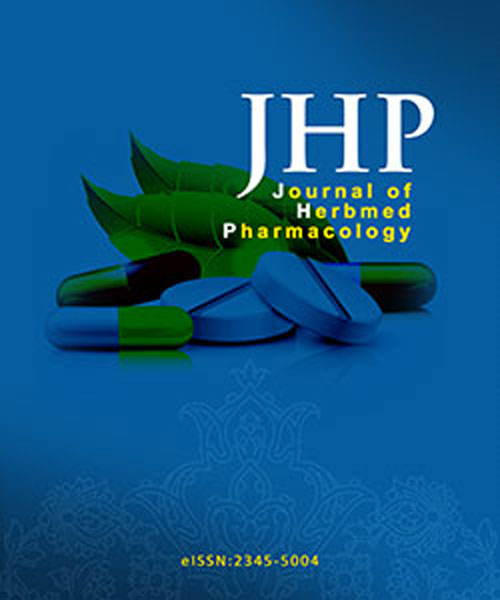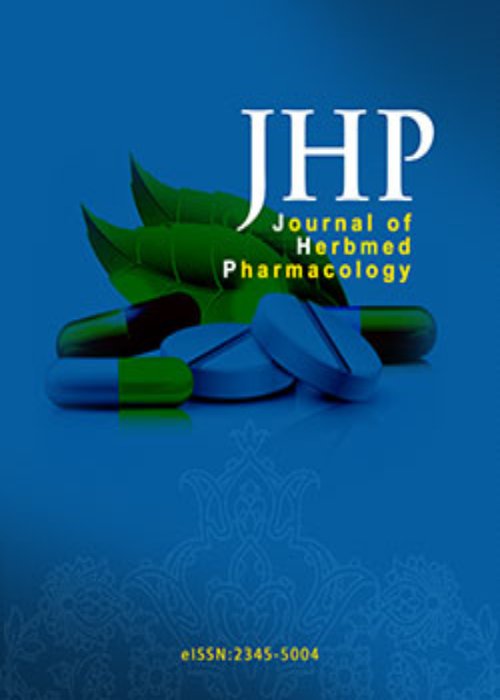فهرست مطالب

Journal of Herbmed Pharmacology
Volume:4 Issue: 4, Oct 2015
- تاریخ انتشار: 1394/07/06
- تعداد عناوین: 8
-
-
Pages 110-114IntroductionIn malaria treatment protocols, treatment failure or drug resistance of synthesized drugs like alkaloids related to quinine, and aminoquinolines are the main problems now. Therefore, discovering efficient drugs or combination therapy of blood schizonticidal drugs with different mechanisms or different targets in the parasite is a crucial effort to solve this problem. In this study, the effectiveness of Crocus sativus Stigma (saffron) individually and in combination with chloroquine, was considered against chloroquine–sensitive strain of Plasmodium berghei.MethodsAt the first stage, using 4 day suppressive Peter’s test in mice, ED50 and survival times of saffron methanol extract, and its aqueous and ethyl acetate fractions and chloroquine on P. berghei were calculated. Then, based on the toxicity and survival time results, combination therapy was conducted with the best saffron fraction and chloroquine against the parasite.ResultsThe saffron extract, aqueous and ethyl acetate fractions resulted in suppression of parasitemia with ED50 values of 587.0 ± 78.7, 323.7 ± 37.2, and 508.7 ± 35.6 mg/kg, respectively. Combination of ethyl acetate fraction with chloroquine, potentiated the antimalarial property and the survived percent of the treated mice on days 7, 14, and 28 significantly more than chloroquine or ethyl acetate fraction alone.ConclusionSaffron and its fractions individually can be effective in reducing the parasitemia in mice. The outcome of combination of ethyl acetate fraction with chloroquine on the mice showed synergistic effect on the chloroquine–sensitive strain of parasite.Keywords: Crocus sativus, Saffron, Plasmodium berghei, Combination therapy, Chlor
-
Pages 115-120IntroductionThe present study is the first assessment of the fatty acids of leaf and essential oil compositions of new three habitats of aerial parts of K. odoratissima.MethodsThe aerial parts of K. odoratissima from the three habitats were dried. The essential oils were obtained by hydrodistillation for 3 h in a Clevenger-type apparatus, then the analysis of the components was carried out using gas chromatography–mass spectrometry. To study the oil yield and fatty acids, the dried leaves subjected to extraction in hexane by using Soxhlet Apparatus. To analyze fatty acids from the oil fractions by gas chromatography technique, the oil was subjected to transesterification to obtain the fatty acid methyl esters, which, were dissolved in hexane and subjected to GC analysis.ResultsAccording to the results, a total of 43 components, the major constitutes of essential oil compositions were (Z)-Ligustilide (76.45%), Unknown-A (4.47%), (E)-Ligustilide (2.57%), (Z)-Butylidene phthalide (2.37%), 5-pentyl cyclohexa-1,3-diene (1.57%) and Kessane (0.77%) in K. odoratissima. The sixteen fatty acids were separated from the oil (5% yield per 100 g dry matter). Linoleic acid (25.46%), α-Linolenic acid (16.66%), Palmitic acid (11.92%), Oleic acid (9.33%), Stearic acid (4.72%), Petroselinic acid (2.53%), Arachidonic acid (2.51%) and Erucic acid (1.76%) were major fatty acids.ConclusionGenerally, K. odoratissima is a rich source of essential fatty acids and phthalide derivatives, specially (Z)-ligustilide. This study was presented valuable information about the phytochemical properties, which can be useful for the future researches on the pharmacological effects of K. odoratissima.Keywords: K. odoratissima, Essential oil, Fatty acids, Z, Ligustilide, Omega, 3, Omega, 6
-
Pages 121-124ntroduction: Prostate cancer is the second leading cause of cancer-related deaths and the mostcommon cancer diagnosed in men in the United States and Europe. Hesperetin, a member of thef lavonoids with antioxidant property, is found in fruits such as oranges and red fruits. This study was undertaken to evaluate the effects of hesperetin on apoptosis induction and inhibition of cell proliferation in the prostate cancer PC3 cells.MethodsPC3 cell line was cultured in standard condition. The cells were exposed to differentconcentrations of hesperetin (0-1000 μM) for 48 hours. Cell viability was measured by MTT assay.Apoptosis induction was assessed by Annexin V-FITC by flow cytometry analysis.ResultsThe PC3 cells exposed to hesperetin (0-1000 μM) exhibited an IC (inhibitoryconcentration of 50%) about 450 μM. At different concentrations of hesperetin (400, 450 and 500µm), the apoptosis increased slightly (not significant) in treated PC3 cells compared to the controlgroup (5.4%, 7.8% and 9.1% respectively vs. 4.2%).ConclusionThese results clearly show that hesperetin can lead to inhibition of PC3 cellsproliferation.Keywords: Prostate cancer, Hesperetin, Apoptosis
-
Pages 125-128ntroduction: Giardia lamblia is an important and prevalent parasitic cause of diarrhea andgastroenteritis. Regarding the significance of giardiasis treatment particularly by medicinal plantsand G. lamblia resistance to chemical drugs, this study was conducted to study in vitro effect ofValeriana officinalis hydroalcoholic extract on G. lamblia cysts.MethodsIn this experimental, laboratory study the hydroalcoholic extract of V. officinalis atconcentrations of 12.5, 25, 50, 100, and 200 mg/mL was applied on G. lamblia cysts. The findingswere compared with controls.ResultsMean results of the effect of V. officinalis hydroalcoholic extract at different concentrationson G. lamblia cysts after 1, 6 and 24 hours demonstrated that the extract at all concentrations causeda notable decrease in alive cysts, with more intensive effect at 100 and 200 mg/mL concentrationsand 100% fatality after 1 hour. As the extract concentration decreased, the speed of G. lamblia cystsinhibition declined.ConclusionV. officinalis hydroalcoholic extract might be recommended as an effective compoundfor removing G. lamblia protozoan cysts, although further studies are needed to show this effect onhuman.Keywords: Giardia lamblia, Valeriana officinalis, ydroalcoholic extract, In vitro
-
Pages 129-132IntroductionAcute lymphoblastic leukemia (ALL) is the most prevalent leukemia in children. Fruits and plants have a wide range of biological functions including anti-proliferative effect. Gallic acid (GA), is a polyhydroxyphenolic compound that is widely distributed in the natural plants. The aim of the present study was the evaluation of the effect of GA on proliferation inhibition of Jurkat cells, the lymphoblastic leukemia cell line.MethodsJurkat cell line was cultured in blood cells culture media in a standard conditions with different concentrations of GA (0-100 μm) for 24, 48 and 72 hours. The effect of GA on cell viability was measured using MTS assay.ResultsDecline of cell viability to less than 50% was observed at 60, 50 and 30 μm concentrations after 24, 48 and 72 hours incubation time, respectively.ConclusionThe results demonstrated that the polyphenolic compound, GA with antioxidant capability is effective in proliferation inhibition in Jurkat lymphoblastic leukemia cell line with a time and dose dependent manner. Therefore, GA may be a potential compound for cancer prevention and treatment.Keywords: Gallic acid, Jurkat cell line, Acute lymphoblastic leukemia, Proliferation
-
Pages 133-137IntroductionArctium lappa (Great burduck) and Artemesia absinthium are medicinal plants that some of their antibacterial and antivirus properties have been suggested in nutritional industries. The objective of this research was to study the effects of A. lappa and A. absinthium on some microorganisms including Pseudomonads aeraginosa, Haemophilus influenza, Bacillus subtilis, Bacillus cereus, Klebsiella pneumonia and Staphylococcus aureus.MethodsExtracts were prepared by maceration method and tested on Mueller Hinton agar medium based on disc diffusion method. The minimum inhibitory concentration (MIC) and minimum bactericidal concentration (MBC) were determined by micro-dilution method. Antibiotic disks used for controlling and standardizing the examination.ResultsThe extracts of A. lappa and A. absinthium had significant effect on S. aureus. The MIC and MBC concentrations of the extract of A. lappa on B. subtilis were respectively 600 and 750 mg/ml. Also, these values were 230 and 540 mg/ml for H. influenza. Extract of A. absinthium showed more inhibitory effect on B. subtilis. All extracts showed inhibitory effect on B. cereus. The extracts of A. lappa and A. absinthium had inhibitory effects on H. influenza and P. aeraginosa. Among antibiotics, only Ofloxacin and Ciprofloxacin had effects on H. influenza. Extract of A. lappa showed flimsy effect on K. pneumonia, while extract of A. absinthium had no effect on this bacterium.ConclusionDue to the effects of A. lappa and A. absinthium on some bacteria, they might be good substitutes for synthetic substances.Keywords: Arctium lappa, Artemesia absinthium, Haemophylus influenza, Antibacteria drugs
-
Pages 138-141IntroductionCandidiasis is a fungal infection caused by Candida albicans. Recentstudies suggest that the side effects of herbal drugs with significant therapeutic effectsare far less than chemical drugs. This study was therefore, conducted to examineantifungal activities of Zataria multif lora and Nigella sativa extracts on C. albicans.MethodsPowders of Z. multif lora and N. sativa were macerated with ethanol 70% and evaporatedat 38˚C by rotary evaporator. The suspension of C. albicans was prepared according to McFarlandat a concentration of approximately 0.5-2.5 × 10CFU/ml. Testing was performed according tomicrobroth dilution in 96-well micro-dilution plates. Minimum inhibitory concentration (MIC),MIC50%, MIC90% and minimum fungicidal concentration (MFC) were separately evaluated bycounting the fungal colonies for Z. multif lora and N. sativa.ResultsThe measured values of MIC, MIC50%, MIC90% and MFC of Z. multiflora on the C.albicans were 0.13, 0.38, 0.74 and 1.03 mg/ml, and those of N. sativa were 10, 27.7, 52.3 and 72.3 mg/ml, respectively.ConclusionThe results indicate that both Zataria multiflora and Nigella sativa extracts are effectiveagainst Candida albicans, but the former species has the highest antifungal activity. If the clinicaltrials confirm the results of this study, Z. multiflora, as a new antifungal agent by replacing chemicaldrugs can be used to develop antifungal medicinal herbs.Keywords: Candida albicans, Zataria multiflora, Nigella sativa
-
Pages 142-148IntroductionSkin aging starts at around age of 30 with wrinkling and pigmentations as its mainindicators. Delay and prevention of aging is a major concern for a great number of people. Thepurpose of this research was to develop and evaluate the efficacy of an anti-wrinkle tomato lotion,consisting of 5% w/w tomato powder in an oil-in-water (O/W) emulsion.MethodsDifferent O/W emulsions were prepared and stability tests were done on them. Theformulation that successfully passed the stability tests, was chosen and the Solanum lycopersicumpowder was added to the oily phase of this O/W emulsion. The prepared lotion was evaluated forpharmaceutical tests. In vitro permeation studies were performed to measure permeation throughcellulose acetate membrane by diffusion cell at sink condition. In vivo trial for examination of theanti-wrinkle efficacy of lotion was done on 10 healthy women as case group compared with 10volunteers using the placebo lotion (lotion base without Solanum lycopersicum powder) as controlgroup.ResultsAccording to the experimented results on the formulated lotion, the efficient time durationfor lotion effectiveness was 42 days. Tomato powder formulated in base of lotion significantlydecreased wrinkles. Our formulation was compatible with skin and caused no sensitivity reactionin human modelsConclusionThe Lycopene in Solanum lycopersicum in this formulation has anti-aging effect. Thisformulation might be a strong candidate for treatment of skin wrinkles.Keywords: Lycopene, Solanum lycopersicum, In vivo test, Wrinkle


